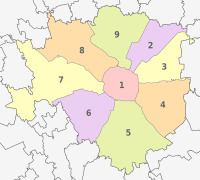 | ||
The current administrative division of Milan, Italy comprises nine zones (zone di decentramento, "decentralization zones" since 1999; municipi, "municipalities" since 2016) numbered from 1 to 9. The organization was established in 1997, implemented in 1999 and reformed in 2016; prior to that the city was divided in 20 administrative zones.
Contents
Borough council
Each borough has a local government called "Consiglio di Municipio" ("municipal council"). The council has 41 members for boroughs exceeding 100,000 inhabitants, and 31 members for smaller boroughs. Each borough has a president.
While the 1997 plan was intended to ascribe several rights and functions to borough councils, this has been largely unattended, so that borough councils have, in practice, little power and few duties. Some of the actual functions of borough councils are:
After the 2016 administrative reform, borough councils are responsible also for running most local services, such as schools, social services, waste collection, roads, parks, libraries and local commerce.
Since 2016, every President is elected directly by population; for the current legislature (2016–21), presidents elected on 5 June 2016 are:
The nine boroughs
With the exception of Zona 1, which corresponds to the historical centre of the city (defined as the part of the city that used to be surrounded by the old Spanish walls, now mostly demolished), boroughs are organized in a sunburst pattern, and numbered from the north-east zone clockwise (see picture above). While boroughs are mostly referred to by number, each borough also has an official name, usually a list of its main districts or areas.
Current boroughs are described in the table below, along with their names, area and population (as of 2014), as well as a list of the main districts comprising each zone. Note that districts (quartieri) are informal (they are not administrative divisions).
